In October 2024, Bitcoin's market share climbed to 70.1%, while the Layer 2 landscape continued to evolve, with Bitcoin L2 growing faster than Ethereum L2.
Written by: Stella L
Sixteen years after Satoshi Nakamoto released the Bitcoin white paper on October 31, 2008, Bitcoin once again demonstrated its revolutionary impact on the financial world. In October 2024, driven by strong institutional investor interest, Bitcoin approached its historical high, while the entire blockchain ecosystem continued to develop rapidly. This month highlighted a clear market differentiation, with Bitcoin leading the market with a 15.9% increase, while Ethereum's growth was more moderate, and the Layer 2 solutions of both networks continued to improve and expand. Meanwhile, emerging public chains like Sui showed strong momentum, poised to enter the top ten public chains.
This report's data comes from Footprint Analytics' public chain research page, which provides an easy-to-use dashboard containing the most critical statistics and metrics in the public chain field, updated in real-time.
Market Overview
In October 2024, the market experienced significant differentiation, with Bitcoin leading while other cryptocurrencies saw relatively moderate gains. Bitcoin performed exceptionally well, rising from $60,764 to $70,398, an increase of 15.9%, and reaching a recent high of $72,751 on October 29, close to the historical peak in March. In contrast, Ethereum's performance was more subdued, with a monthly increase of 2.7%, closing at $2,519.
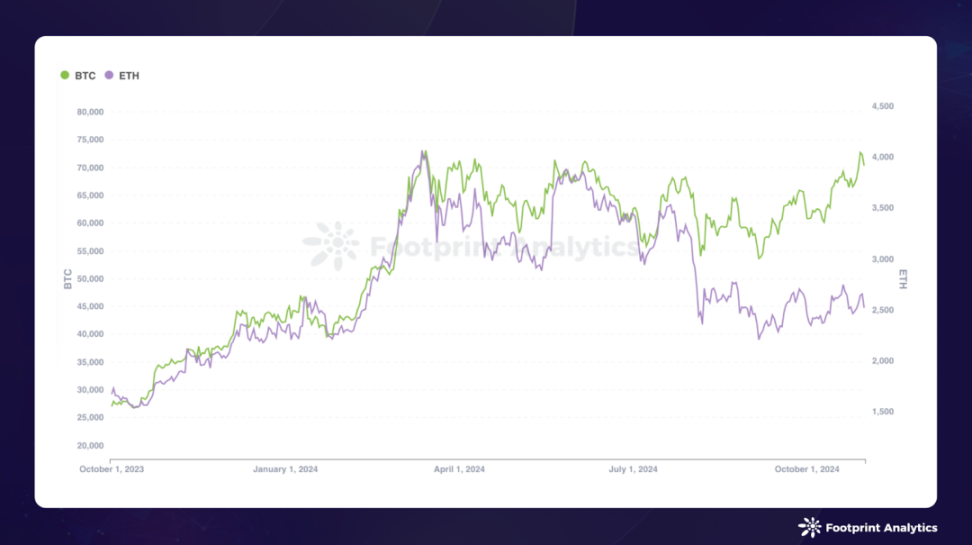
Data source: Bitcoin and Ethereum price trends
Several macroeconomic factors influenced market trends this month. Changes in the global currency market, particularly the strengthening of the US dollar against major currencies including the Chinese yuan, affected the flow of funds into the cryptocurrency market. This shift occurred against a backdrop of rising bond yields and increasing gold prices, reflecting changes in global market risk appetite.
Political factors increasingly impacted market sentiment, with the upcoming US elections becoming a significant market driver. Investors positioned themselves ahead of potential policy changes, accelerating Bitcoin's gains, while the market closely monitored how different election outcomes would affect digital asset regulation and broader financial policies.
Institutional participation remained a crucial driving force in the market, as evidenced by significant inflows into Bitcoin exchange-traded products (ETPs). This trend highlights the growing recognition of digital assets as strategic investment tools among institutional investors, even as they adopt a more cautious investment stance.
Regulatory dynamics continued to influence the market landscape. The FBI's investigation into NexFundAI tokens through "sting operations" marked a significant milestone, leading to market manipulation charges against three cryptocurrency companies and 15 individuals. Meanwhile, Crypto.com's legal battle with the SEC underscored the ongoing tension between industry participants and regulators.
Layer 1
In October 2024, the total market capitalization of blockchain cryptocurrencies grew by 6.7% to $2.0 trillion, with Bitcoin's market dominance increasing from 67.3% in September to 70.1%. Meanwhile, Ethereum's share continued to decline, dropping from 16.8% to 15.3%, while the shares of BNB Chain and Solana remained relatively stable at 4.2% and 4.0%, respectively.
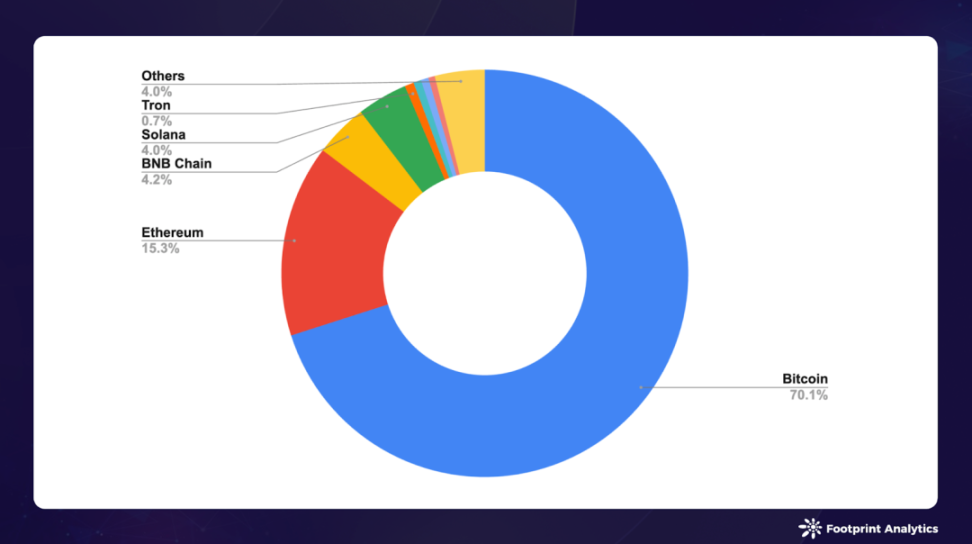
Data source: Public chain token market capitalization
Market growth was primarily driven by the strong performance of mature tokens, with Bitcoin leading the way, followed by Bitcoin Cash (12.9%) and Litecoin (9.5%), which also saw significant gains. Solana maintained its position as one of the best-performing altcoins, rising by 17.6%. Meanwhile, the emerging blockchain Sui continued its upward momentum, increasing by 11.5%.
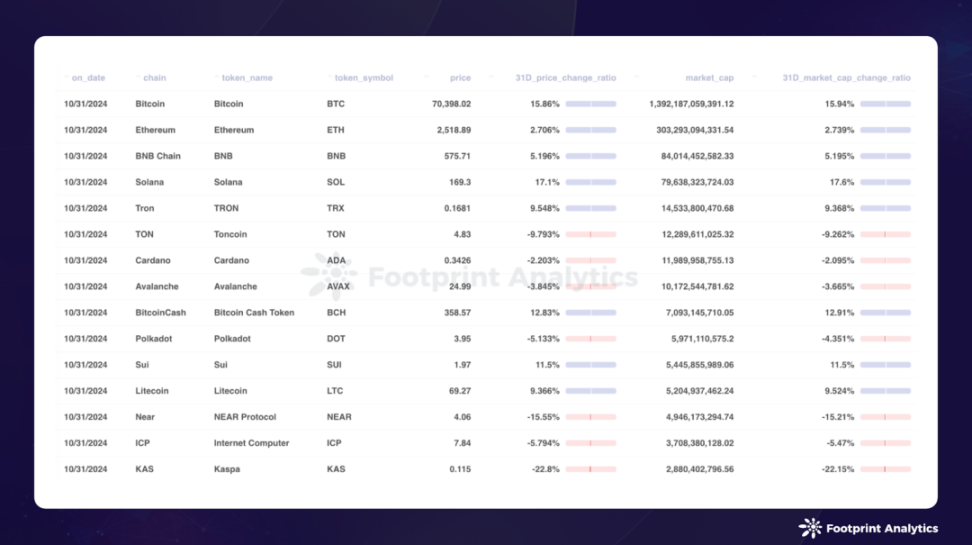
Data source: Public chain token prices and market capitalization
Sui's market capitalization ranking rose to 11th place. By capitalizing on the meme coin trend and Telegram-based gaming opportunities, Sui significantly expanded its DeFi ecosystem. The launch of native USDC on Sui by Circle in October marked another milestone in its development. However, this growth was not without controversy—allegations of a "$400 million token sell-off by Sui insiders" in October, although denied by the Sui Foundation, sparked community discussions.
The DeFi sector faced headwinds in October, with total TVL declining by 6.8% to $63.5 billion. While the Bitcoin ecosystem performed strongly, the DeFi segment of the Ethereum ecosystem struggled. Notably, Polygon was an exception, with its TVL increasing by 30.3%, primarily due to heightened activity ahead of the US presidential election, driving Polymarket to set records.
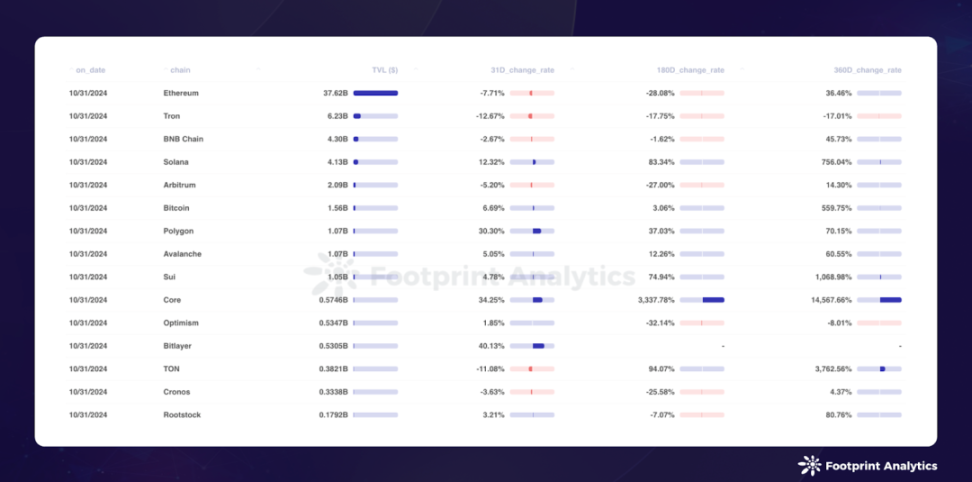
Data source: Public chain TVL
Stablecoins continued to demonstrate their critical role in the crypto ecosystem. Bitwise Research's Q3 2024 crypto market review indicated that global stablecoin trading volume exceeded $5.1 trillion in the first half of 2024, approaching Visa's $6.5 trillion trading volume. Tether's profitability surpassing BlackRock highlighted the financial influence in this sector, intensifying competition among public chains to launch stablecoins.
Bitcoin Layer 2 & Sidechains
In October 2024, Bitcoin Layer 2 and sidechains continued to show strong growth, with total TVL reaching $1.8 billion, a 22.2% increase from September.
Core maintained its industry-leading position, with TVL growing by 29.8% to $570 million, capturing a market share of 32.4%. Bitlayer solidified its position, with TVL increasing by 36.1% to $530 million, holding a 29.9% market share. Rootstock ranked third with a TVL of $180 million and a 10.1% market share, while BSquared emerged strongly, with a TVL of $170 million, a monthly growth of 54.4%, surpassing Merlin to rise to fourth place.

Data source: Bitcoin ecosystem public chain TVL
October witnessed significant technological breakthroughs in the Bitcoin Layer 2 ecosystem. BEVM launched the innovative "Super Bitcoin" framework, proposing a comprehensive solution to expand its functionality while maintaining the foundational security of Bitcoin.
This framework proposed a five-layer architecture based on the Bitcoin network, utilizing its proven PoW consensus to ensure security. Building upwards, it integrated Lightning Network technology for efficient communication, Taproot consensus for standardization, and a multi-chain integration layer supporting various virtual machines. This architecture ultimately formed an application layer, enabling developers to build DApps while leveraging Bitcoin's security.
In a significant initiative connecting the Bitcoin and Ethereum ecosystems, the BOB network announced integration with Optimism's "Super Chain." As a self-proclaimed "hybrid layer-2" solution, BOB aims to create a seamless connection between Bitcoin and Ethereum, placing Bitcoin at the center of the DeFi space.
Cross-chain functionality further developed with the integration of Cardano and BitcoinOS (BOS). This collaboration aims to provide users of the established public chain Cardano with direct, trustless access to Bitcoin liquidity.
Additionally, BTCFi continued its impressive growth trajectory, particularly with Babylon's Bitcoin staking program Cap-2. This program demonstrated significant efficiency, attracting 23,000 Bitcoins while incurring only 1.56 BTC in minimum fees. This successful deployment showcased the strong market demand for Bitcoin-based financial products.
Ethereum Layer 2
In October 2024, Ethereum Layer 2 solutions achieved moderate growth, with the total TVL of standardized bridges reaching $19.8 billion, a 1.2% increase from September, significantly lagging behind the growth rate of Bitcoin's scaling solutions. The competitive landscape continued to evolve, with established leaders maintaining dominance but losing market share, while new entrants made notable progress.
Market leaders Arbitrum One and Optimism retained their positions with market shares of 45.3% and 17.8%, respectively, although both experienced slight declines. Base saw significant growth, with its market share expanding from 8.1% to 13.4%, and TVL increasing by 28.5%. This growth was primarily attributed to Coinbase's smart wallet, which simplified dApp interactions and attracted substantial inflows in lending, derivatives, and DEX protocols. Base's native DEX Aerodrome performed excellently during this expansion.
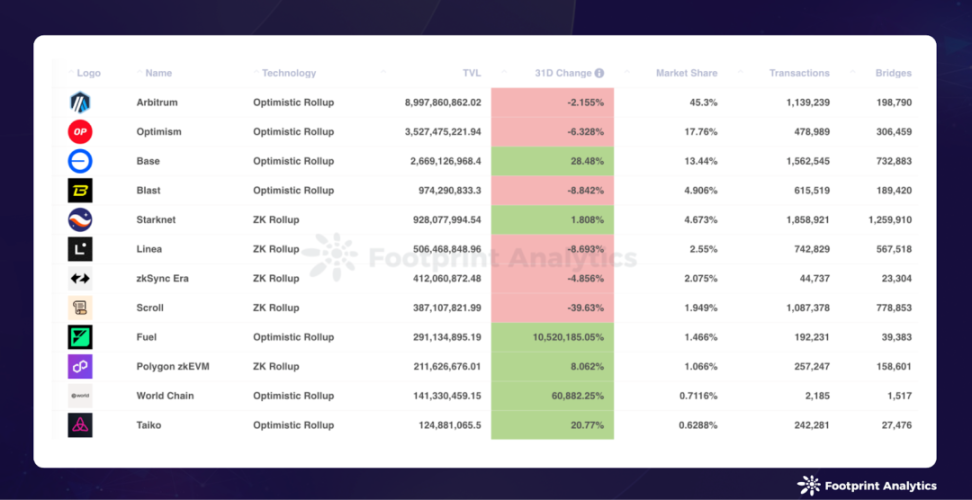
Data source: September 2024 Ethereum Layer 2 Overview - Rollups (bridge-related metrics)
Several new entrants made a significant impact. Fuel Ignition and World Chain saw substantial TVL growth after their mainnet launches, while Taiko's TVL increased by 20.8% driven by the success of Panko Finance and Avalon Finance.
However, Scroll experienced a 39.6% decline in TVL following its airdrop. Its airdrop activity faced community controversy over the allocation plan, and similar to previous cases with zkSync and Starknet, post-airdrop activity significantly decreased, with its token price dropping over 50% from the issuance price.
Beyond market metrics, the industry has also intensified its focus on the fundamental challenges facing the ecosystem, particularly regarding user experience and interoperability.
Vitalik Buterin has been actively involved in addressing community concerns, publishing a series of comprehensive articles discussing the future direction of Ethereum. He posted multiple articles on social media, particularly emphasizing that cross Layer 2 interoperability is a key development priority. The roadmap he submitted outlines improvements aimed at unifying the Ethereum ecosystem through standardizing chain-specific addresses, a unified payment request system, and cross Layer 2 integration of key storage wallets. These enhancements are designed to simplify cross-chain asset transfers while reducing Gas fees for cross Layer 2 transactions.
Despite ongoing challenges, Ethereum's Layer 2 ecosystem continues to attract significant projects and developments. October witnessed several notable mainnet launches. World Network (formerly Worldcoin) went live, bringing its privacy-focused identity solution to the mainnet. Yuga Labs launched ApeChain, developing NFT applications leveraging Ethereum's security, while Eclipse and Fuel Ignition completed their mainnet deployments, adding new scaling solutions to the ecosystem.
Another important development came from Uniswap Labs, which announced plans for Unichain, a new Layer 2 network built on Optimism's OP Stack. Given Uniswap's dominance in the DeFi space, this announcement sparked extensive industry discussion. Following major players like Coinbase's Base and Sony's Soniem, the launch of Unichain's testnet signals a potential shift in Layer 2 competitive dynamics, with future competition intensifying in terms of liquidity and Gas fees.
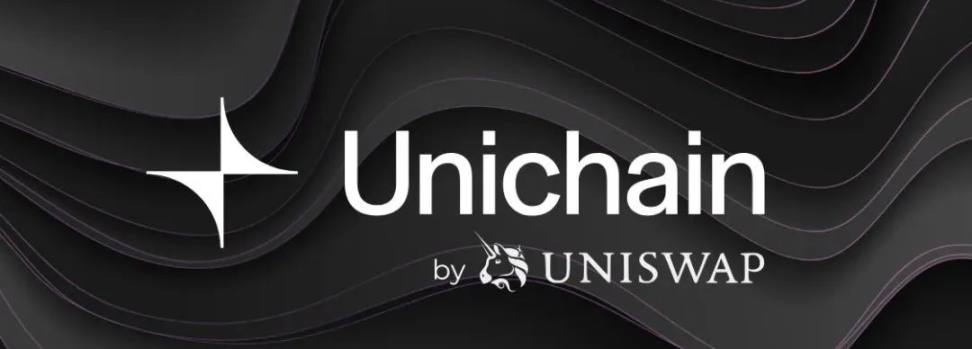
Unichain
Blockchain Gaming Public Chains
In October 2024, the blockchain gaming sector had 1,606 active games, with BNB Chain, Polygon, and Ethereum dominating game distribution. OpBNB led user engagement with an average of 1.2 million daily active users (DAU), followed by Ronin (886,000 DAU) and Matchain (548,000 DAU).

Data source: Proportion of active blockchain games across public chains
Matchain achieved a significant breakthrough in October, surging from an average of 78 daily DAU in September to 548,000 DAU through Telegram-based games. The chain peaked at 3.3 million users on October 12, stabilizing at around 615,000 users by the end of the month, showcasing the potential and volatility of Telegram-based user acquisition strategies.
Sui and Core showed strong growth, with DAU increasing by 105.1% to 190,000 and 75.7% to 109,000, respectively, both leveraging Telegram-based initiatives. Meanwhile, TON's DAU decreased by 27.7% to 195,000. Although its pioneering Telegram-based strategy has inspired the adoption of several public chains, including Sei, Ancient8, and Viction, user retention remains a common challenge faced by the entire industry.
_For more data insights, please refer to the _October 2024 Blockchain Gaming Research Report: Latest Trends in Active Users and On-Chain Game Ecosystem Interpretation.
Financing Situation
In October 2024, the blockchain sector recorded 12 financing events, totaling $104 million, a 40.1% decrease from September's $174 million. Three of these events did not disclose specific financing amounts.
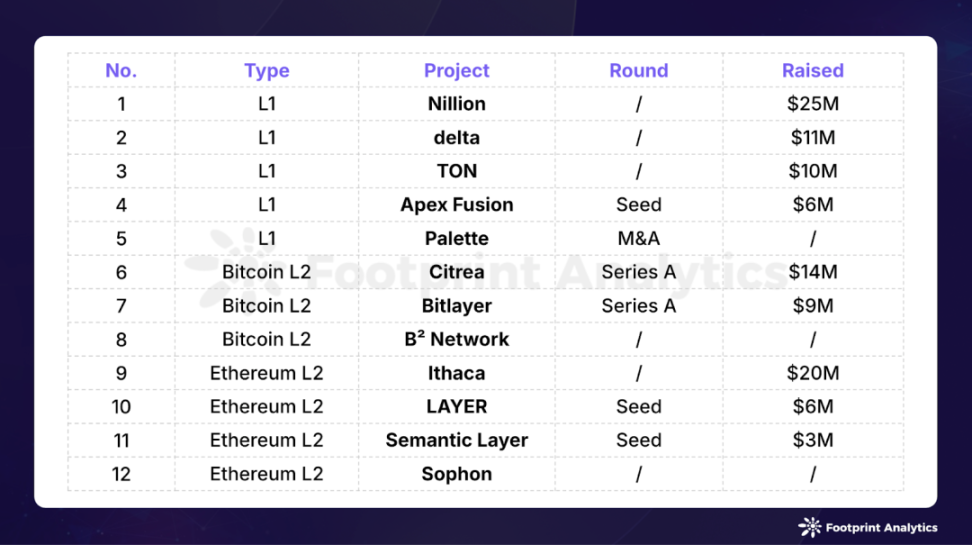
October 2024 Public Chain Financing Events (Data Source: crypto-fundraising.info)
Privacy-focused blockchain project Nillion became the largest recipient of financing in October, raising $25 million in a funding round led by Hack VC. The project's innovative "blind computing" method allows data to be processed without exposing its content, enabling applications to collaborate while maintaining data privacy. This groundbreaking technology positions Nillion at the intersection of privacy protection and decentralized computing, meeting the growing demand for secure data processing in Web3 applications.
After securing a $30 million investment from Bitget and Foresight Ventures in September, TON continued to maintain its financing momentum. In October, TON received funding support from Gate.io.
Layer 2 solutions continue to attract investor attention across both the Bitcoin and Ethereum ecosystems. Bitcoin Layer 2 platforms Bitlayer and B² Network successfully completed new rounds of financing, while the Ethereum Layer 2 space saw funds flowing into innovative projects, including Ithaca, Semantic Layer, Sophon, and LAYER.
免责声明:本文章仅代表作者个人观点,不代表本平台的立场和观点。本文章仅供信息分享,不构成对任何人的任何投资建议。用户与作者之间的任何争议,与本平台无关。如网页中刊载的文章或图片涉及侵权,请提供相关的权利证明和身份证明发送邮件到support@aicoin.com,本平台相关工作人员将会进行核查。




